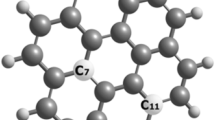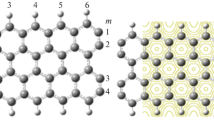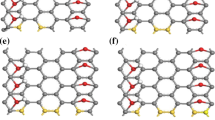Abstract
Ab initio calculations based on density functional theory (DFT) were used to investigate the structural, electronic and optical properties of ZnS graphene based (GB) with N and H atoms as ligands. These studies were conducted using the generalized gradient approximation (GGA) by means of WIEN2k package and revealed how the electronic and optical properties of GB structures of ZnS, including density of electron states, the energy band structure, the dielectric function, the energy loss function, the refractive index, the reflection and absorption rates, are modified by the effects of H and N impurities. Band structure analysis indicated that ZnS GB is a semiconductor with direct band gap (3.4 eV) in Γ direction. Furthermore, it has been found that H (ligand) and N (ligand) atoms that bond to a Zn atom cause magnetic and half-metallic behaviors, and one or two electronic states appeared in the energy gap at down spin for H and N ligands, respectively.











Similar content being viewed by others
References
Luo X, Cao W, Zhou L (2007) Synthesis and luminescence properties of (Zn, Cd)S: Ag nanocrystals by hydrothermal method. J Lumin 122–123:812
Karar N (2007) Photoluminescence from doped ZnS nanostructures. Solid State Commun 142:261
Antony A, Murali KV, Manoj R, Jayaraj MK (2005) The effect of the pH value on the growth and properties of chemical-bath-deposited ZnS thin films. Mater Chem Phys 90:106
Ludolph B, Malik MA (1998) Novel single molecule precursor routes for the direct synthesis of highly monodispersed quantum dots of cadmium or zinc sulfide or selenide. Chem Commun 17:1849
Zhao Y, Zhang Y, Zhu H, Hadjipanayis GC, Xiao JQ (2004) Low-temperature synthesis of hexagonal (Wurtzite) ZnS nanocrystals. Chem Soc 126:6874
Prè MD, Morrow I, Martin DJ, Mos M, Negro AD, Padovani S, Martucci A (2013) Preparation and characterization of down shifting ZnS:Mn/PMMA nanocomposites for improving photovoltaic silicon solar cell efficiency. Mater Chem Phys 139:531
Yu Z, Leng J, Xue W, Zhang T, Jiang Y, Zhang J, Zhang D (2012) Highly flexible transparent and conductive ZnS/Ag/ZnS multilayer films prepared by ion beam assisted deposition. Appl Surf Sci 258:2270
Chen D, Huang F, Ren G, Zheng M, Wang Y, Lin Z (2010) ZnS nano–architectures: photocatalysis, deactivation and regeneration. Nanoscale 2(10):2062
Krainara Norawit, Limtrakul Jumras, Illas Francesc, Bromley ST (2011) Structural and electronic bistability in ZnS single sheets and single-walled nanotubes. Phys Rev B 83:233305
Scheuschner N, Ochedowski O, Kaulitz A-M, Gillen R, Schleberger M, Maultzsch J (2014) Photoluminescence of freestanding single- and few-layer MoS2. Phys Rev B 89:125406
Topsakal M, Cahangirov S, Bekaroglu E, Ciraci S (2009) First-principles study of zinc oxide honeycomb structures. Phys Rev B 80:235119
Behera H, Mukhopadhyay G (2012) Strain-tunable band parameters of ZnO monolayer in graphene-like honeycomb structure. Phys Lett A 376:3287
Ajmal Khan M, Bouarissa N (2013) Optical and energy-loss spectra of ZnS from ab initio molecular dynamics simulation: temperature effect. Optik 124:5095
Lashgari H, Boochani A, Shekaari A, Solaymani S, Sartipi E, Mendi RT (2016) Electronic and optical properties of 2D graphene-like ZnS: DFT calculations. Appl Surf Sci 369:76
Freeman CL, Claeyssens F, Allan NL, Harding JH (2006) Graphitic nanofilms as precursors to wurtzite films: theory. Phys Rev Lett 96:066102
Zhang S, Ma J (2011) Width- and edge-dependent stability, electronic structures, and magnetic properties of graphene-like and wurtzite ZnS nanoribbons. J Phys Chem C 115:4466
Wang P, Jiang T, Zhu C, Zhai Y, Wang D, Dong S (2010) One-step, solvothermal synthesis of graphene-CdS and graphene-ZnS quantum dot nanocomposites and their interesting photovoltaic properties. Nano Res 3:794
Sookhakian M, Amin YM, Baradaran S, Tajabadi MT, Golsheikh AM, Basirun WJ (2014) A layer-by-layer assembled graphene/zinc sulfide/polypyrrole thin-film electrode via electrophoretic deposition for solar cells. Thin Solid Films 552:204
Fu X, Jiang T, Zhao Q, Yin H (2012) A facile synthesis of graphene–metal (Pb, Zn, Cd, Mn) sulfide composites. J Mater Sci 47:1026. doi:10.1007/s10853-011-5890-0
Zhao J, Yang X (2003) Photocatalytic oxidation for indoor air purification: a literature review. Build Environ 38(5):645
Liu JZ, Yan PX, Yue GH, Chang JB, Qu DM, Zhuo RF (2006) Red light photoluminescence emission from Mn and Cd co-doped ZnS one-dimensional nanostructure. J Phys D Appl Phys 39:2352
Sheng-Zhi L, Jin-Chao L, Xiang-Dong Y, Yan-Feng G, Hai-Quan X (2010) First-principles calculation of ZnS doped with Mn or Fe. Chin J High Press Phys 24:449
Schwarz K, Blaha P (2003) Solid state calculations using WIEN2k. Comput Mater Sci 28:259–273
Zakharov O, Rubio A, Blase X, Cohen ML, Louie SG (1994) Quasiparticle band structures of six II–VI compounds: ZnS, ZnSe, ZnTe, CdS, CdSe, and CdTe. Phys Rev B 50:10780
Marinara N, Limtrakul J, Illas F, Bromley ST (2011) Structural and electronic instability in ZnS single sheets and single–walled nanotubes. Phys Rev B 83:233305
Topsakal M, Cahangirov S, Bekaroglu E, Ciraci S (2009) First-principles study of zinc oxide honeycomb structures. Phys Rev B 80:235119
Behera Harihar, Mukhopadhyay Gautam (2012) Strain-tunable band parameters of ZnO monolayer in graphene-like honeycomb structure. Phys Lett A 376:3287
Bouarissa N (2000) The effect of hydrostatic pressure on the electronic and optical properties of InP. Solid State Electron 44:2193
Ajmal Khan M, Bouarissa N (2013) Optical and energy-loss spectra of ZnS from ab initio molecular dynamics simulation: temperature effect. Optik 124:5095
Author information
Authors and Affiliations
Corresponding author
Rights and permissions
About this article
Cite this article
Boochani, A., Akhtar, A., Amiri, M. et al. Effects of hydrogen and nitrogen impurities on electronic, structural and optical properties of 2D ZnS graphene based. J Mater Sci 52, 10393–10405 (2017). https://doi.org/10.1007/s10853-017-1198-z
Received:
Accepted:
Published:
Issue Date:
DOI: https://doi.org/10.1007/s10853-017-1198-z




